
by John Glynn | May 4, 2017 | New Models, Porsche News
The Gen 2 991 GT3 PDK has just had its first public hot laps around the Nürburgring and set a time 12 seconds quicker than the outgoing model. 7 mins 12.7 seconds is between 2 and 3 percent quicker than the old car, so will such a modest increase hurt sales of Gen 2s?
Autocar magazine released its first drive of the Gen 2 991 GT3 Manual earlier this week and Greg Kable was quick to point out that the Gen 2 PDK is substantially quicker on track. “But as spectacularly good as the manual version of the new Porsche 911 GT3 is – and it really is stunningly effective – I wouldn’t recommend it to anyone who intends to do an intensive amount of track day running…In ultimate performance terms, the PDK model is king.” This being the case, how much slower than a Gen 1 GT3 PDK would one be around the Nürburgring in a Gen 2 Manual? And would a slower Gen 2 Manual matter?
Manual transmission matters for the emotional response to total control, or so the experts say. But how many cars would one sell with the headline: “the Gen 2 GT3 Manual is ten seconds slower than the old car around the Nürburgring, but you told us you wanted three pedals for those 1500 miles a year, so here you go”?
Manufacturers need to upgrade, renew and keep pace with the competition and find the USPs that set their latest creations apart from the old ones but, at some stage, the actual users of a thing (rather than speculators/investors/collectors or whatever the latest word is) run out of real reasons to ‘upgrade’. A two year-old iPhone 6S Plus does basically the same job as the latest one, a four year-old Macbook Pro does pretty much the same job as a new one and a 17 year-old Volkswagen Polo ticks the same ‘get from A-B’ box as a new one, so why bother with new things at all?
Of course, stuff wears out when it gets used a lot and replacements are then a necessity, but few people are wearing out Gen 1 GT3s. If the upgrade path is all about egos aching for shiny, then Porsche is mining a rich psychological seam. Stuttgart delivered just shy of 60,000 cars in Q1 2017 (another record, one imagines). To make and deliver all of these cars, the company now employs 28,249 people. Profit margins have also risen and are now running at 17.6 percent on a total revenue of €5.5 billion.
No prizes for guessing that 911 GT3s are not top of the sales charts, but they must be pretty close to the top in the league table of press coverage year-on-year. The column inches guarantee all Gen 2 GT3s will be sold, so maybe it makes little difference how quick the car is. Then again, it has to be quicker or the press won’t play ball.
If I didn’t already have a Gen 1 991 GT3 and someone offered me a Gen II build slot, I would buy the manual regardless of whether it was ten or even twenty seconds slower. But, if I already owned a Gen 1 GT3 and had to find a chunk of change to get in a manual that was slower on track? That is a different scenario.
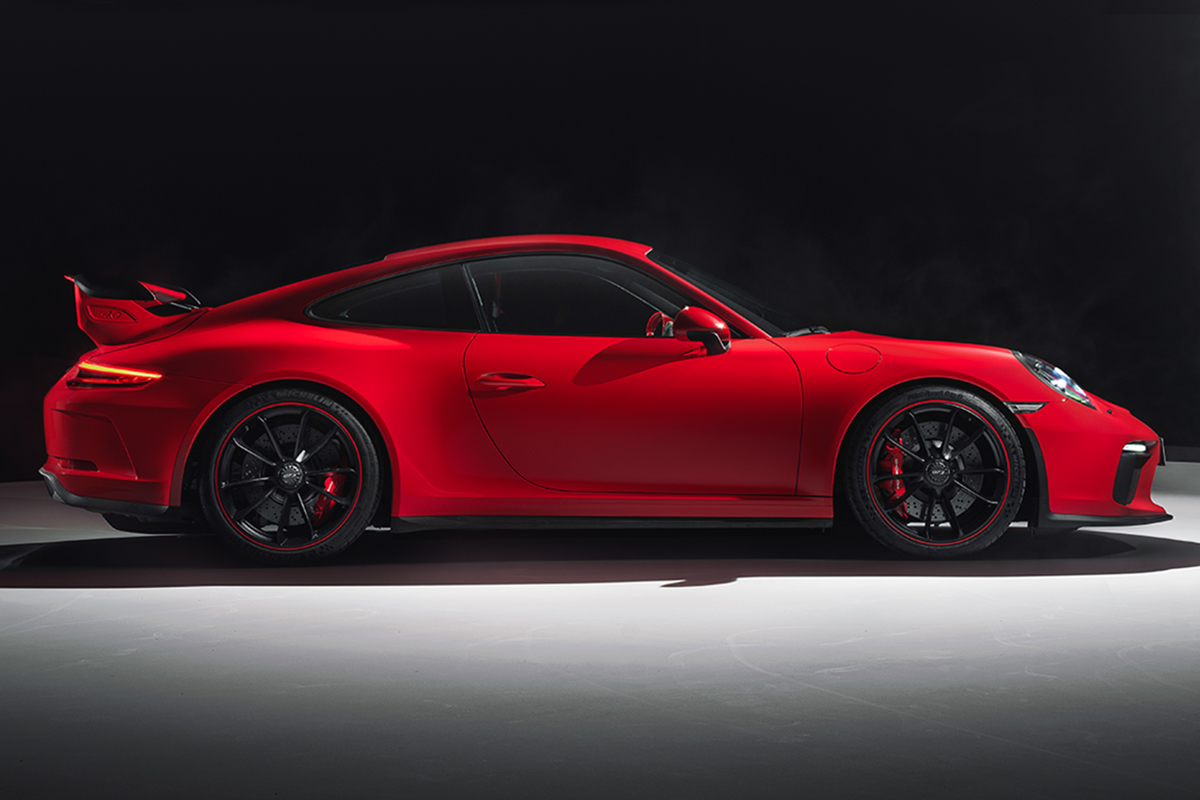
by John Glynn | Mar 7, 2017 | New Models, Market & Prices
The new Porsche 991 GT3 was launched today at Geneva in a supersized Internet love-in. If you like massive sportscars weighing 1500 kilos then you are probably all over it: I hope you will pardon the rest of us for a certain lack of euphoria. It is nothing personal.
The new GT3 looks almost exactly the same as the old one, with the one big change of manual transmission. It is a small but very satisfying detail. When the 991 GT3 was first launched with PDK only, there was uproar online, but it didn’t hurt the showroom one bit. Despite the early cars catching fire when con rod bolts snapped, causing boiling oil to pour onto hot exhausts and send the cars up in smoke, Porsche sold every single 991 GT3 it could build.
And Stuttgart built lots of them: estimates suggest more than 6k cars, which is far more than any previous 911 GT3. Magazines were rinsed and repeated in PR about how PDK was the gold standard in race cars and how it was faster around the blah blah blah etc, and they all lapped it up. Driving a Gen I Porsche 911 GT3 around a car park was enough to put me off and visiting a PDK repair shop just confirmed the position. Anyone with an ounce of 911 soul might have seen the writing on the wall for the PDK-only plan, as the cars were not that nice to drive ‘normally’.
Despite the PDK-only thing and a non-stop production line, used GT3s soon hit 50% over list. Many 991 GT3ers cashed out, switching back to the Gen II 997 GT3 and RS with manual transmission and sending prices for those cars through the roof. The switch did not escape Stuttgart’s product chiefs, who then announced a limited edition 911R with manual shift, allowing them to test latent demand. When that model was oversubscribed several times over (the eternal new-Porsche battle of drivers vs sellers), it was obvious that 911R development was not money wasted. All the PDK spiel was deleted from memory and the stick shift was on its way back to GT3 land.
Now the Gen II 991 GT3 with manual transmission has been announced and I have already had calls from price-conscious insurance valuation customers, asking what various GT Porsches might be worth in part exchange: a topic for another time. More interesting is what a 911R is now worth.
We have all seen 911Rs listed anything up to £500k. The most recent car sold in public was the Slate Grey McQueen one in Paris, which went for £451,000 ($553,000) including premium. However, if you’ve spent enough money with your local Porsche dealer in the last few months, you can now order a 490bhp/197mph 911 GT3 with manual transmission for prices starting at £112k: essentially what a nice-spec used LHD Gen 1 991 GT3 example costs in the UK .
No doubt 911R is still a major collectable, but the £400k prices may have just left the building. As for 997.2 GT3 RS and 4-litre RS, we will see what happens. Maybe nothing – probably not very much.

by John Glynn | Nov 16, 2016 | Race and Rally, New Models
Porsche has finally unveiled the new 911 RSR. Debuting at the Los Angeles Motor Show, the new 911 race car will make a few more public appearances before its racing debut at Daytona in January. The new RSR will be seen at nineteen events during the 2017 season, with two works entries each for the WEC GT and IMSA championships.
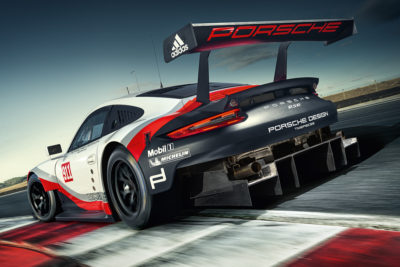
Built “to the full breadth of the Le Mans 24 Hours GT regulations”, the new RSR runs a 991-derived four litre, 510 horsepower flat six in a mid-engine layout. This fundamental change to the 911 concept has allowed the designers to run a mahoosive rear diffuser working with a huge rear wing, designed using lessons learned on the 919 LMP1 car. This makes the RSR much more efficient.
“This is the biggest evolution by now in the history of our top GT model,” said Dr. Frank-Steffen Walliser. “For the 911 RSR, we deliberately focused on a particularly modern and light normally-aspirated engine, as this gave our engineers immense latitude in developing the vehicle. Apart from that, in principle, the LM-GTE regulations stipulate the absolute equality of various drive concepts, as the torque characteristics of turbo and normally aspirated engines are aligned.”

Interestingly, Weissach has gone with what it says is a new safety cage concept and a new, rigidly-mounted racing seat. With the seat fixed to the chassis, the pedals are moved and adjusted to fit each driver. Also fitted is a collision avoidance system, which warns the drivers of incoming LMP cars. The dashboard looks utterly mental – good luck to the drivers of this one.
The new RSR made its track debut in March 2016 and has since covered more than 35,000 kilometres in testing across Europe and North America. All that testing has given Porsche plenty of time to design a photogenic livery (including PD logo and Porsche Design mentions) for the one-and-a-quarter tonne racecar, but all we want to know is: can it kick arse? And who’s going to drive it in WEC? All will be revealed.

by John Glynn | Apr 25, 2016 | New Models, Porsche News
Porsche has launched the new 718 Cayman with four-cylinder turbocharged engines, redesigned dashboards and LED lights setting it apart from the previous model. Basic price for the 2-litre 300 hp Cayman is £39,878, with the basic 2.5-litre, 350 hp Cayman costing from £48,834: a difference of £8956.
Porsche Cayman now cheaper than Boxster
The new list prices position Cayman below its soft-top Boxster sibling, which starts at £41,739.00 for the 2-litre manual. Add £1922 for PDK, taking the pre-options price to £43,661. Boxster S starts at £50695: £8956 more than the 2-litre car: same as the 718 Cayman.

There are subtle differences under the skin, with firmer springs and anti-roll bars and tweaked damper settings. Steering is ten per cent ‘more direct’ and rear wheels are a half inch wider, general increased lateral grip. The Porsche Torque Vectoring (PTV) electronically-controlled rear limited slip differential is an option. Brakes have been upgraded, now with 330mm front discs and 299mm rears. 2-litre Cayman uses the previous Cayman S calipers, while the 718 Cayman S gets 911 Carrera calipers, with 6mm thicker discs.
Outgoing Cayman was quite a pretty car and the new one looks pretty similar to me. Front end is maybe a bit sharper, with bigger intakes and new LED running lights. 918-style LED headlamps with four-point daytime running lights are an option. The rear now has a gloss black badge panel with four brake lights, which Porsche says “appear to float freely”.
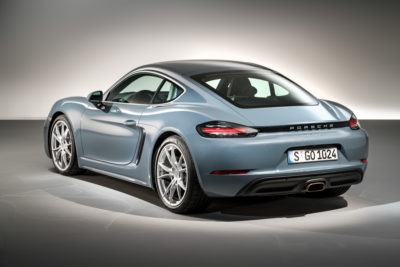
The Cayman will need more than floaty brake lights to capture buyers imagination. Porsche sports cars (i.e. sports cars and not sports SUVs) now account for something like 30% of sales and the 911 takes the lion’s share of that. Caymans are hard work in the used market and struggle to find buyers quickly, even when keenly priced, which keeps trade demand and residual values challenging.
Company car users have been known to opt for Caymans and no doubt will continue to do so, but it’s hard not to wonder about the strength of support amongst private buyers for Cayman, given the cost of a reasonably-equipped example and the number of more versatile premium alternatives now available.
Having a relevant, desirable sports car other than the evergreen 911 is important to preserve brand perception/positioning for the SUVs, so the four-cylinder engines and price drop to below the soft top probably make sense. They make much more sense than diluting the 718’s place in history by pimping those numbers on the back of a Cayman, regardless of how floaty the brake lights are.

by John Glynn | Apr 12, 2016 | New Models, Porsche News
Our man in Portugal, José Luis Stock, recently sent me some photos from the official press launch of the Porsche Boxster 718, the turbocharged four-cylinder car which Stuttgart has seen fit to rebrand with the iconic 718 label, presumably to head off criticism that real Porsche sports cars have flat-six engines. Personally, I don’t think anyone would have been that bothered and they could have left it alone, but what do I know.
José is the brother of Fernando Stock, famous Portuguese rally driver of the 1950s who took a Porsche 356 to the Monte Carlo Rally back in the day. José is a man who still loves his Porsches, so it must have been a pretty cool experience to walk into a car park and find the very latest Porsche sports car parked in front of him: yet another upside to living in sunny Southern Europe.
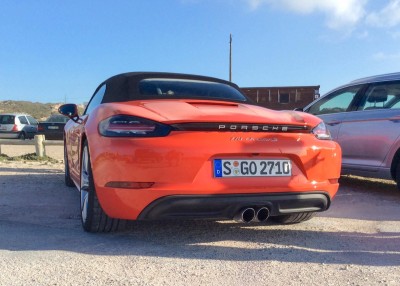
Porsche Boxster 718 reviews
Reviews of the Porsche Boxster 718 have been circulating for a week or so, and the general consensus amongst road test editors is that it’s a reasonable effort. EVO magazine’s Dan Prosser is one of my Porsche road test benchmarks and his review of the new Boxster S was an interesting read, particularly for his robust remarks on the character of Porsche’s new four-cylinder engine.

“Even with the sports exhaust fitted, the new engine is fairly characterless in the way it sounds,” says Prosser. “It doesn’t want for volume at idle and the sound is a dirty, gruff sort of warble with Subaru undertones, but it isn’t tuneful. Unfortunately, it doesn’t improve once on the move and with the roof up it’s actually very droney. The note does harden over the final 1000rpm, but the long and short of it is that the Boxster is no longer a car that can be enjoyed for the way it sounds.”
Not quite what the Doctor would have ordered if he were still with us, and even less so when the price is factored in. The new Boxster S costs a staggering £50,695. Add five grand more for ceramic brakes, a grand for 20″ wheels and £1100 for Sport Chrono Plus. Hard to believe that a new Boxster S is the best thing you can do with £60k of hard-earned, but UK Porsche sales are up year-on-year.
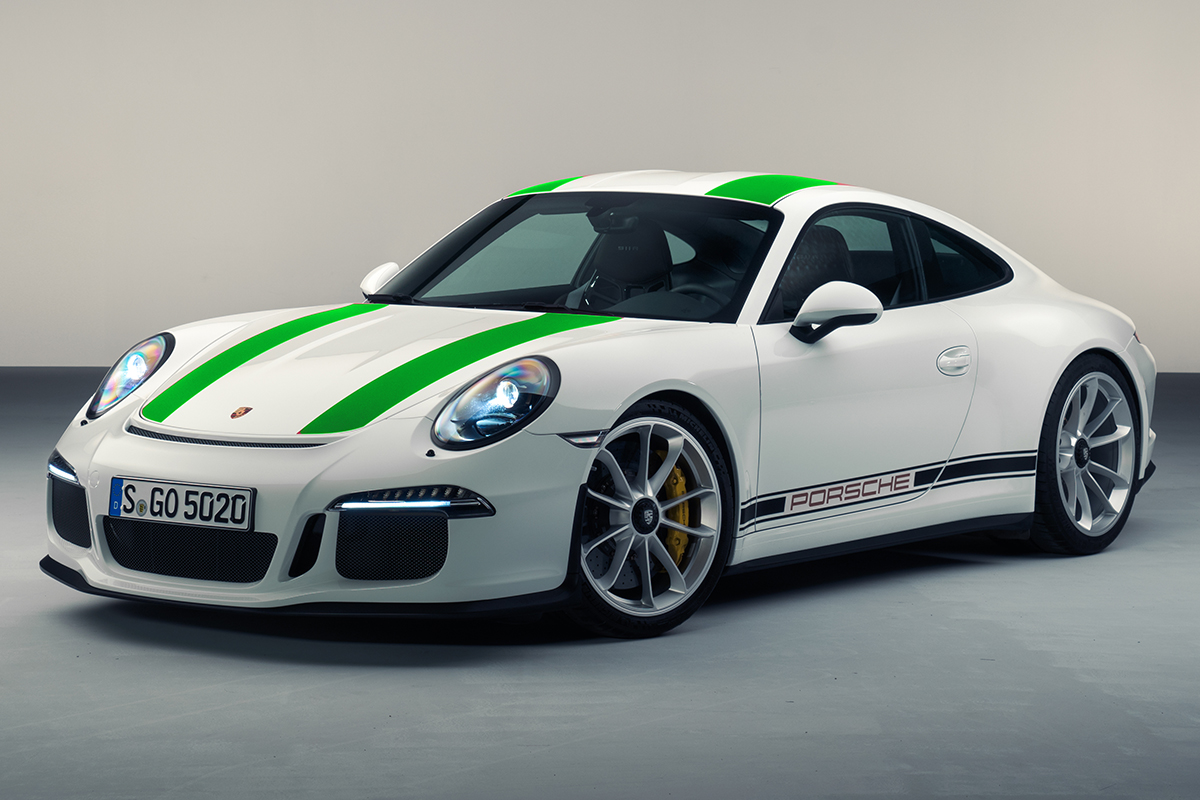
by John Glynn | Apr 3, 2016 | New Models, Classic Porsche Blog
The all new Porsche 911R is one to forget for most Porsche would-be buyers, as Stuttgart continues to apply a policy of limited production range-toppers, which instantly doubles prices once the cars are flipped on to the used market by speculator purchasers.
Marketed as ultimate driver’s cars, the irony is that the majority of the nine-hundred and ninety-one 911Rs to be built will not be driven by their first owners. Most will either be mothballed on delivery and stuck in pension-fund car collections or sent straight back to market at up to £200k more than the UK cost new of £136,901.

Porsche 911R Factory Options
Obviously that cost new does not include the options that most buyers who manage to secure a build slot will go for. Choice of seats is standard (although there is really only one choice), as are the mechanical LSD, six-speed gearbox and ceramic brakes. But a quick look at the car configurator shows the other boxes likely to be ticked, based on the most common GT3 RS options out there (i.e. what Porsche dealers will advise customers to add), including:
- Wheels in Satin Platinum: £400
- Extended Leather: £2000
- LED headlights in Black: £2100 (or cheaper Black Xenon for £800)
- Lightweight Battery: £1500
- Single Mass Flywheel: £2024
- Front Axle Lift: £2024
- Sport Chrono: £1525
- Climate Control: £0
I pick the green stripe no-cost option, as any good Irishman should. Adding heated seats for early-morning starts means I would have to give up the 918 seats, which I wouldn’t do. So no 911R for me. Adding the DAB Radio means also adding PCM Navigation (no cost) and Telephone Module, so a £500 increase. The system won’t let you unhook Porsche Vehicle Tracking system at £1100, so your invoice total is now £147,000.
Porsche 911R Used Prices
Send in your deposit and finance the rest: don’t worry about interest. Sign your finance agreement when the car arrives at the dealership. As soon as the car is delivered, stick it in the Sunday Times at £350,000, which is the price 991 GT3 RSs were changing hands for when the first ones hit the UK and what my dealer friends expect ‘black market’ flipped 911Rs to fetch in the first weeks after delivery. Pay off your finance and buy the best 997 Carrera GTS you can find, as that is super fun to drive. Enjoy your free 911 and all that money for nothing.

What Porsche to buy if you can’t buy a 911R
Porsche must be happy for buyers to flip for profits: just look at the prices one-owner 911 GT3 RS models are selling for under the radar through its own dealer network. If Stuttgart was serious about building driver’s cars accessible to everyone, it would only make one less 911R than the market called for, and then we could all look forward to the day they depreciate to 997 Carrera GTS levels, which in my opinion currently offers the best mix of affordability, excitement and driveability in the 911 line up. I’ll have mine in white with green R stripes.
I would love to try a 911R with this six-speed transmission: no doubt the six-speed manual gearbox is huge fun in a 997 Carrera GTS and the seven-speeder is not great in a 991. By ignoring 991s and looking at Gen II 997 Carrera GTS instead, you really do not have to spend a fortune to buy the most enjoyable and guilt-free driver’s 911 of the VW-Porsche era.














